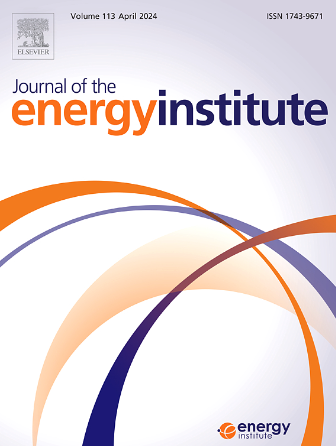Co-pyrolysis of Chlorella pyrenoidosa and polystyrene: kinetics and product distributions
IF 5.6
2区 工程技术
Q2 ENERGY & FUELS
引用次数: 0
Abstract
Co-pyrolysis of algae with polystyrene (PS) offers a promising and efficient approach to enhancing the quality of algae-derived bio-oil. This study investigated the thermal decomposition behavior, activation energy, and product distribution during the co-pyrolysis of Chlorella pyrenoidosa (CP) and PS. Thermal decomposition behavior was analyzed using non-isothermal thermogravimetric analysis (TGA) at heating rates of 10–40 °C/min. The activation energies were calculated using the OFW, KAS, and STK methods. Product distributions were examined using Py-GC/MS at 600 °C. TGA results revealed that the co-pyrolysis of CP and PS proceeded through four stages. Increasing CP proportions shifted pyrolysis temperatures toward higher values. The addition of PS significantly reduced the apparent activation energy, with the strongest positive synergistic effect at a CP5PS5 ratio. The average apparent activation energies for CP5PS5 were 180, 179, and 179 kJ/mol, as determined by the OFW, KAS, and STK methods, respectively. Py-GC/MS analysis revealed significant changes in the bio-oil composition with increasing PS content. The yields of MAHs and PAHs increased, while aliphatic hydrocarbons, oxygen-containing compounds, and nitrogen-containing compounds decreased. At a CP5PS5 ratio, MAHs increased to 67.09 %, PAHs increased to 30.22 %, oxygen-containing compounds dropped to 2.05 %, and nitrogen-containing compounds became undetectable. Co-pyrolysis of algae with PS provides a simple, effective, and scalable approach for upgrading bio-oil quality while simultaneously contributing to the management of plastic waste.
核核小球藻与聚苯乙烯共热解:动力学及产物分布
藻类与聚苯乙烯(PS)共热解是提高藻类生物油质量的有效途径。研究了pyrenoidosa小球藻(Chlorella pyrenoidosa, CP)和PS共热解过程中的热分解行为、活化能和产物分布,采用非等温热重分析(TGA)对其在10 ~ 40℃/min的升温速率下的热分解行为进行了分析。采用OFW、KAS和STK方法计算活化能。在600°C下使用Py-GC/MS检测产品分布。TGA结果表明,CP和PS共热解经历了四个阶段。CP比例的增加使热解温度向更高的值移动。PS的加入显著降低了表观活化能,且在CP5PS5比下正协同效应最强。采用OFW法、KAS法和STK法测定CP5PS5的平均表观活化能分别为180、179和179 kJ/mol。Py-GC/MS分析显示,随着PS含量的增加,生物油的组成发生了显著变化。多环芳烃和多环芳烃的产率增加,脂肪烃、含氧化合物和含氮化合物的产率降低。在CP5PS5比下,MAHs增加到67.09%,PAHs增加到30.22%,含氧化合物下降到2.05%,含氮化合物无法检测。藻类与PS的共热解为提高生物油质量提供了一种简单、有效、可扩展的方法,同时有助于塑料废物的管理。
本文章由计算机程序翻译,如有差异,请以英文原文为准。
求助全文
约1分钟内获得全文
求助全文
来源期刊

Journal of The Energy Institute
工程技术-能源与燃料
CiteScore
10.60
自引率
5.30%
发文量
166
审稿时长
16 days
期刊介绍:
The Journal of the Energy Institute provides peer reviewed coverage of original high quality research on energy, engineering and technology.The coverage is broad and the main areas of interest include:
Combustion engineering and associated technologies; process heating; power generation; engines and propulsion; emissions and environmental pollution control; clean coal technologies; carbon abatement technologies
Emissions and environmental pollution control; safety and hazards;
Clean coal technologies; carbon abatement technologies, including carbon capture and storage, CCS;
Petroleum engineering and fuel quality, including storage and transport
Alternative energy sources; biomass utilisation and biomass conversion technologies; energy from waste, incineration and recycling
Energy conversion, energy recovery and energy efficiency; space heating, fuel cells, heat pumps and cooling systems
Energy storage
The journal''s coverage reflects changes in energy technology that result from the transition to more efficient energy production and end use together with reduced carbon emission.
 求助内容:
求助内容: 应助结果提醒方式:
应助结果提醒方式:


